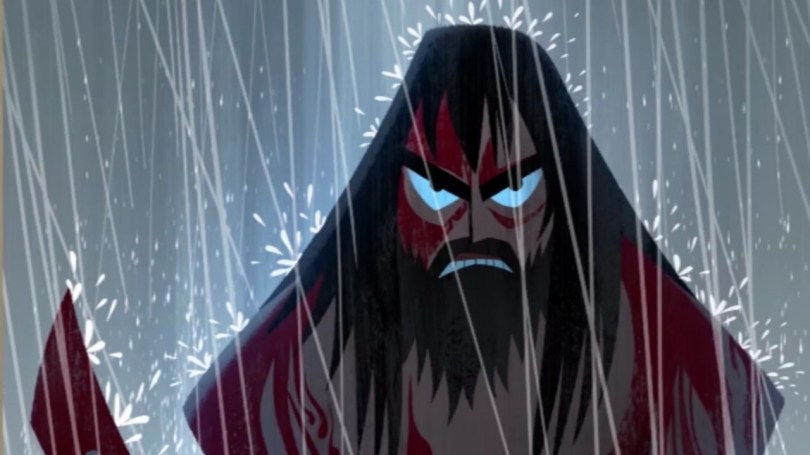Let’s get the part where I explain my relationship with Samurai Jack out of the way really quick. I was 9 when the series premiered, and but 11 by the time it was off the air. But when it was on, and for years afterwards while reruns ran in syndication, I was hooked. It helped that my dad, not a guy who is big on cartoons, also liked the show, which meant it was a special bonding thing for me and him. The excellent colors, the innovative lack of black outlines on characters, the tasteful use of music and even silence, and the themes of an honorable samurai, lost in time, on a quest to stop the greatest evil from coming into power in his own time thousands of years in the past? It has the recipe for all kinds of greatness, and it takes a man like Genndy Tartakovsky, the genius behind the Cartoon Network tentpole series that was Dexter’s Laboratory, to make it all come together.
Which is why I was so pleased when Scaramouche (voiced by voice acting hero and notable square yellow sponge, Tom Kenny), the musical robotic assassin in the season 5 premiere, called Jack’s beard “rugged” a clear reference to one of the best Dexter’s Laboratory episodes where Dexter grows a beard so he can be “rugged” like Action Hank on TV (and in real life). It’s a good line on so many levels, because it works if you’re just catching back up with Jack and the beard is just a notable departure, but it’s also great if you know Dexter’s Lab and get the small, unobtrusive but also quite funny reference. And it really helps set the tone of the series straight. Because while this Jack is darker, grittier, and edgier than he was almost 15 years ago, he’s still Jack. There is humor to be had, there is light at the end of the tunnel. Even if it doesn’t seem that way, for Jack, or for us.
We find Jack 50 years after he first arrived in the future, and he appears surprisingly not too much worse off at first. He’s got a cool bike, cool new armor, and he’s got guns and blades aplenty. But he hasn’t aged at all; he’s stuck in time. He’s having hallucinations about his parents and the people he “left behind” in the past. And perhaps most devastating of all, it’s revealed that he lost his sword. Meanwhile, a group calling themselves the “Daughters of Aku” have been raising seven girls to be assassins with the sole goal of killing Jack since their birth. Just as the episode ends, their training is complete and they are sent to find the samurai.
This premiere was pretty much all set up, interspersed around a pretty kickass fight scene between Jack, sword-less, and Scaramouche. And that’s fine, because we’re finally getting a mini-series from Jack, instead of exclusively standalone series and two-parters. There are exciting possibilities before us. What happened to Jack’s sword, and how will he retrieve it? Who are the Daughters of Aku, and are the seven girls actually created using Jack’s genetic material (the theory du jour in this writer’s eyes)? Will the one standout from the Daughters, Ashi, end up joining Jack? The possibilities are exciting, and I’m almost disappointed that the whole series wasn’t dropped at once, Netflix style. But then we wouldn’t get weeks of excitement and speculation!
The show has had to evolve in the intervening decade and a half though. The visuals and music haven’t missed a beat since 2003, even if the style has changed just a bit, especially evident in the one flashback we see of Jack losing his sword, where Jack’s jawline just isn’t the same. And while we do hear just a little bit of the Aku through a cellphone, voiced by Greg Baldwin, it’s going to be hard to handle thechange since the devastating passing of Mako. It’s also notable that part of the power of the original Samurai Jack was its ability to tell self contained but incredibly odd stories week to week. We will have to see if Jack can handle more longform storytelling, although I must admit I have every confidence in Mr. Tartakovsky and his team.
Here’s to Jack being back, and him being just as good, and hopefully better. This samurai must get back to the past, but he shouldn’t stay in our past. Thanks Genndy, see you next week.






